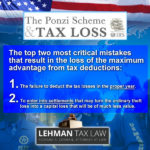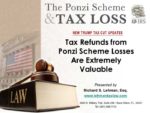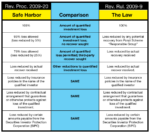REPORT No. 1: FTX and Sam Bankman-Fried Fraud by Richard S. Lehman, United States Tax Attorney

The following is Report No. 1 in what is intended to be a series of reports focusing on the tax benefits available as a result of the FTX fraud. These Reports are not intended to be and can not serve as legal advice to any reader.
Each taxpayer has their own unique factual situation which is going to need to be reviewed by tax advisors and litigation counsel before any legal conclusions can be reached. The Reports are being made in a series form since there is still a great deal of facts to be uncovered in the FTX fraud. These facts are going to be extremely important in coming to conclusions about tax positions.
Furthermore, there could be guidance from the I.R.S. in this particular situation or any number of other factors that require the subject matter to be updated on a continual basis. The FTX fraud has resulted in much pain throughout the world. Hopefully some of this can be eased in the form of tax relief from either the U.S. or other countries whose citizens are entitled to permit their financial losses to be deducted from their taxes.
The FTX Tax Losses – The Basics
The FTX fraud was a Ponzi scheme and losses from Ponzi schemes are acknowledged by the I.R.S to be “theft losses”. They are deductible from a taxpayer’s ordinary income.
The theft loss tax deduction is an extremely valuable tax deduction and for many victims of the FTX fraud the deduction will have a cash value equal to 35% or more depending upon state and city income taxes. Investors who are subject to federal, state, and city income tax may find that their recovery from the tax loss is equal to almost 50% of their theft loss.
There are several methods of tax recovery that are available to Ponzi scheme victims. However, each of these potential options of recovery have their limitations, restrictions, and strict requirements that must be met if one is to take advantage of the maximum tax benefits from the FTX theft.
The two most critical mistakes that result in the loss of the maximum advantage of these tax deductions seem to be:
- the failure to deduct the tax losses in the proper year, and
- to enter into settlements that may turn the ordinary theft loss into a capital loss that will be of much less value. The latter can occur for example, if an investor were to accept shares of stock as part of a settlement and then those shares of stock (a capital asset) lost all of their value.
The benefits and the traps make it important to tax plan properly to maximize the tax losses. It is critical that tax advisors and litigation counsel work closely together in order to not foreclose any of the available options for ponzi scheme victims to make use of tax losses. Hopefully, professionals working together will avoid costly mistakes.
In considering the various options of recovery available for tax losses some fundamental knowledge of the law is important. We are going to cover those fundamentals into the following order.
- The Amount of the Theft Loss Deduction
- The Timing of the Theft Loss Deduction
- Tax Loss Carry Forwards
- Deduction in the Year of Loss
- Deduction in Years Other Than the Year of Loss
- Other Sources of Tax Recovery
- Payments Received as a Return of Capital – Not Income
- “Phantom Income” Tax Treatment
- Tax Planning and the Practical Effects of the Tax Rules – Mistakes to Avoid.
The Amount of the Theft Loss
The amount of the theft loss that is deductible is calculated as the tax basis of the lost assets reduced by insurance proceeds recoverable and other claims for which there is a reasonable prospect of recovery.
To result in a tax loss the lost asset must have a tax basis.
If the theft is accomplished in a manner that results in the taxpayer’s failure to include the lost asset in income or if a taxpayer has claimed the amount of the loss as a different type of deduction no theft loss will be allowed. In such a case, there should be no deduction because the lost property would have a zero tax basis.
Example:
A court denied any theft deduction loss for embezzled property where a taxpayer (“Employer”) had already received a tax benefit from the loss through the embezzler’s inflating the taxpayer’s cost of goods sold in order to accommodate the embezzlement. The taxpayer’s former comptroller, (“Employee”) had embezzled more than $700,000 over the preceding seven years. All the embezzlements were accomplished through fictitious charges by the Employee that increased the Employer’s cost of goods sold and reduced the Employer’s taxable income by the embezzled amount each year. There was an economic loss but not a tax loss since the tax loss had already been deducted.
Furthermore, it is recognized that costs such as legal fees incurred in collecting on Ponzi schemes were deductible as a theft loss. Courts have found that these costs and others such as the costs of recovery or salvage are so closely identified with the theft loss itself as to add further theft losses.
BASIS FOR THEFT LOSS TAX DEDUCTION
Assume since 2019 that taxpayer X invests $1.0 million with FTX personally and $1.0 million is invested by the taxpayer’s I.R.A. with FTX.
Assume that by 2022 that each account statement reflected an investment account equal to $2.0 million in taxpayer’s account, and $2.0 million in taxpayer’s I.R.A. The I.R.A. has never been taxed. The taxpayer did pay federal income tax on all of the funds shown as income in the personal account. Assume both accounts totaling $4.0 Million are completely lost.
The taxpayer’s tax loss (not economic loss) for recovery purposes is $2,000,000. The taxpayer invested $1.0 million and “earned” $1.0 million upon which taxes were paid. The $2.0 million in I.R.A. however, has never been taxed before.
The taxpayer has no basis for a tax loss by the I.R.A. Those funds were never taxed, so their loss cannot result in deductible tax loss. In the event the taxpayer received a $100,000 distribution from the I.R.A. account there still would be no effect on tax basis. In this situation the I.R.A. distribution would have been received and a tax paid upon receipt. Clearly, the I.R.A. loss is an economic loss, but it is not translated into a deductible tax loss.
The Timing of the Theft Loss Tax Deduction:
This issue, the timing of the theft loss deduction, is the critical issue in the FTX theft. Most likely, the vast majority of the victims of the fraud will want to claim a theft deduction for the year 2022. Such a claim, if submitted properly may result in the swiftest and largest cash recovery from the theft of all of the sources of recovery. This will be in the form of tax refunds. Furthermore, to the extent the theft losses are not all used as a claim for a refund of prior taxes paid, they will be available to offset future income starting as early as 2022.
A theft loss is treated as sustained during the taxable year in which the taxpayer discovers the loss.
- However, a theft loss is not deductible in the taxable year in which the theft was discovered to the extent that a claim for reimbursement exists and there is a reasonable prospect of recovery of the loss.
- If a theft loss cannot be deducted in all or any portion the year of discovery because a reasonable prospect of recovery of the loss exists, then the theft loss deduction must be taken in the year (s) that it can be ascertained with a reasonable certainly that no further recovery will be received.
- If the taxpayer deducts a theft loss in the year of discovery because no reasonable prospect of recovery exists at that time and the taxpayer later receives compensation or reimbursement, the compensation or reimbursement does not cause a re-computation of the deduction; instead it is included in gross income for the year received.
There are two key phrases to keep in mind when reading these general rules about timing of the deduction.
The first is “reasonable prospect of recovery”. The second phase is “ascertain with a reasonable certainty”. The effect of these phrases on the appropriate timing of a theft loss deduction is as follows:
- A taxpayer who suffers a theft loss should take that theft loss deduction in the year the loss is sustained, which is in the taxable year in which the taxpayer discovers the loss. However, if in the year the taxpayer discovers the loss there is a reasonable prospect of recovering all or some portion of the loss, the taxpayer must postpone taking the theft loss deduction to later years; unless the taxpayer can show that as to all or some portion of the loss there is no reasonable prospect of recovery.
- If the taxpayer does not take a theft loss deduction in the year of discovery, in the following years the taxpayer may not take a theft loss deduction until the year in which the taxpayer can ascertain with reasonable certainty whether the expected reimbursement will in fact be received or not.
- The bottom line is that taxpayers who claim a deduction in the year 2022 for a theft tax loss will require a simpler legal standard of proof to an entitlement to the deduction in that year; than those taxpayers who will be required to prove their entitlement to the theft loss deduction in any other year than the year of discovery.
The Johnson Case – A Real Life Example of What Not to Do
There is one very recent case that involved a “Ponzi like” scheme perpetrated on a Palm Beach couple. This case has added a good deal of clarity to the law on the timing of the theft loss deduction and other related deductions.
In 1997 Palm Beach County residents Aben Johnson and Joan Johnson discovered they were the victims of a fraud scheme involving the purchase of gems and jewelry in which they had lost approximately $78 million. The scheme had lasted from 1988—1997. During almost the entire time of the fraud the Johnsons “income” from their investments in gems was the repayment of their own funds that were paid previously to the perpetrator. Though the Johnsons discovered the fraud in 1997 they did not take any formal actions against the perpetrators of the fraud in 1997. The Johnsons however, did undertake an investigation in 1997.
Clearly, the value of the theft loss deduction was of such a size, that the issue of the timing of the deductions warranted every argument in a tax lawyer’s arsenal. In the course of trying to convince the court of the proper year of the theft loss deduction, the court was asked to choose between the years 1997, 1998, 2001, and 2005.
The court, that decided the last of the three Johnson cases in January of 2012, provided a great deal of guidance for the intelligent treatment of theft losses.
The court in the Johnson case confirmed that in the year of the discovery of the theft, the taxpayer could claim a deduction for that portion of a theft loss that the taxpayer could identify as not having a reasonable prospect for a recovery.
However, the Johnson’s tried to claim all of their theft losses in 1997, not just a designated provable portion that could not be recovered. Since in 1997 there appeared to be many avenues of recovery, this meant there was a “reasonable prospect of recovery” with an unknown amount. Therefore, the court denied the year deduction for the 1997, the year the loss was discovered.
The court found that the year of the discovery of a loss ordinarily should be the proper year of taking the loss. However, if there may be some reimbursement of the loss, and if the extent of the reimbursement is unknown or cannot be quantified in the year of discovery then the loss should not be taken in the year of discovery.
The taxpayers then claimed a major loss in 1998 and in 1998 the taxpayer made a better attempt to quantify the portion of the loss that would not be recovered. However, in 1998 the taxpayer admitted to the fact that they were using “estimates”. Consequently, the court denied any theft loss deduction in 1998.
Since 1998 was not the year of the discovery of the theft by the taxpayers the burden of proving the right to a deduction had changed. In 1998 the taxpayer had to prove not just that there was not a reasonable prospect of a recovery of any portion of the theft loss. The theft loss deduction was denied in 1998 because in that year, in order to receive a theft loss deduction, the taxpayer had to “ascertain with a reasonable certainty” that no further recovery of the loss was possible.
In denying the theft loss deduction for the 1998 the court pointed out that there are two different legal standards and even indicated that evidence that was insufficient to meet the standards of 1998, the year after the date of discovery; may have been sufficient to meet the standards of the year of discovery, 1997.
In denying the 1998 deduction the court stated:
- Several court decisions have tended to combine the “reasonable prospect of recovery” inquiry and the “ascertain with reasonable certainty” inquiry. However, these two inquiries are distinct and the standards to be applied are different . . .
- The taxpayers’ contention that the analysis of their lawyers and accountants is sufficient to “ascertain with reasonable certainty” standard is not supported. By their own admission, plaintiffs state that they made an “estimate” of the amount of recovery . . .
- The analysis performed by the lawyers and accountants may have been sufficient to determine whether there was a “reasonable prospect for recovery” in the year of discovery but it was not sufficient to “ascertain with reasonable certainty” the amount of reimbursement the plaintiffs would receive after a resolution of their reimbursement claims. Thus, the plaintiffs’ theft loss deduction in 1998 based on an “estimate” that was made well before the recovery process was resolved was premature and cannot be sustained.
Since the year 1998 was not the year the theft loss was discovered and since the Johnsons had decided to enter into extensive litigation by 1998, a theft loss deduction could not be taken until the Johnsons could ascertain with a reasonable certainty that the reimbursement will not be received for any portion of the loss.
Again the court’s words defined the higher standard for 1998.
- After having elected to pursue a claim for reimbursement for which there was a reasonable prospect of recovery, the plaintiffs did not “ascertain with reasonable certainty” in 1998 whether or not reimbursement would be received. To ascertain “reasonable with a certainty” whether or not such reimbursement will be received may be, for example, by a settlement of the claim, or by an adjudication of the claim, or by an abandonment of the claim.
- The requirement that a taxpayer “ascertain with reasonable certainty” means that a taxpayer must obtain a verifiable determination of the amount that she will receive, based on a resolution of the reimbursement claim before taking a theft loss deduction. Finally, requiring resolution of the claim with an objectively verifiable amount of loss is, as the government correctly notes, consistent with the plain meaning of “ascertain”… [as defined in a Dictionary of the English Language.]”
It was not before 2001 that the Johnson’s eventually clearly defined with certainty the amount of recovery they would receive and were entitled to a theft loss deduction for the unrecoverable amount.
It is obvious that obtaining the theft loss deduction for the year 2022 will involve as clear an understanding as possible of the characteristics of the two key legal phrases “reasonable prospect of a recovery” and “ascertain with a reasonable certainty”.
Other Sources of Tax Recovery
Investors may not need too be concerned about their ability to recover taxes paid on the phony “profits” that were being credited to investors’ accounts as taxable income. This is often referred to as “Phantom Income.”
Phantom Income in the FTX accounts was typically reported over the years as taxable income on which taxes were paid. These amounts upon which taxes have been paid will be considered part of the investor’s basis and will be part of the loss amount for theft loss deduction whether the funds were actually paid in the account or not.
Furthermore, the tax benefits of the loss of Phantom Income can be accomplished in another way than the theft tax loss deduction.
In the same Johnson case previously discussed, the taxpayer proved to the court that in the last few years of the Johnson Ponzi scheme there never was any significant amount of capital. Therefore since new capital was simply passing through to pay off the investors with their own money, the court permitted the taxpayer to file amended returns that eliminated the Ponzi scheme “false income” or “phantom income” as taxable income.
There is one other theory of recovery. Again it may be only available in the situation where “FTX Income” did not exist at all and that new money did little more than pass through the scheme to pay distributions to old money was not supported by any truth at all. However, under limited circumstances, taxpayers who have received actual cash payments from the Ponzi scheme have been permitted to amend previous returns reflecting those actual payments as a non-taxable return of capital.
# # #
- By Richard S. Lehman, United States Tax Attorney, download this article as a 10 page pdf here.
- GAO: The Report to Congressional Requesters: Customer Outcomes in the Madoff Liquidation Proceedings. https://www.lehmantaxlaw.com/wp-content/media/pdfs/GAOHQ_AS_ISSUED.pdf
- Letter to Richard Lehman, from Christopher H. Schmitt, Senior analyst
U.S. Government Accountability Office
https://www.lehmantaxlaw.com/report-to-congress-on-the-customer-outcomes-in-the-madoff-liquidation-proceeding/
This article has been reposted, with permission from the U.S. corporate offices of Lehman Tax Law: https://www.lehmantaxlaw.com/ftx-ponzi-scheme





